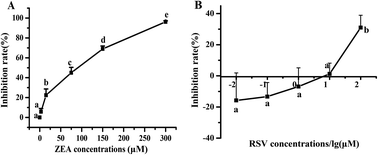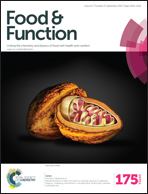The protective effect of resveratrol against cytotoxicity induced by mycotoxin, zearalenone†
Abstract
Zearalenone (ZEA), a non-steroidal estrogenic mycotoxin, is widely present in cereals and agricultural products. The literature reports suggest that oxidative damage seems to be a key determinant of ZEA-induced toxicity, and the protective effect of resveratrol (RSV), an antioxidant phenolic compound, on ZEA-induced cytotoxicity to HEK293 cells was investigated. The experimental results showed that ZEA decreased cell viability in a dose dependent manner with an IC50 value of 80 μM, and induced an increase in intracellular reactive oxygen species (ROS) in HEK293 cells. A remarkable elevation of MDA and decreased activity of manganese superoxide dismutase (MnSOD) were also observed. A decrease in mitochondrial membrane potential (MMP), cell cycle arrest at the G0/G1 phase, and increased cell apoptosis indicate a mitochondria-mediated apoptosis. RSV (2 μM) pretreatment not only recovered the activity of MnSOD, but also improved ZEA-induced cytotoxicity evidenced by increased MMP and cell viability, and decreased ROS. Furthermore, RSV pretreatment substantially upregulated the expression of the SIRT1 gene by 6.8 fold, reduced the acetylation level of the forkhead transcription factor FOXO3a, and decreased the expression ratio of Bax/Bcl-2. All these results demonstrated that RSV exhibited significant protective effects on ZEA-induced cell damage, and this effect may be attributed to the upregulation of SIRT1 and activation of FOXO3a-mediated pathways to enhance the resistance of cells to oxidative stress induced by ZEA exposure.


 Please wait while we load your content...
Please wait while we load your content...